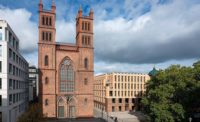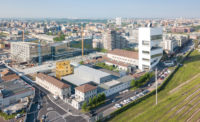A Miami Beach vacation usually has more to do with the fulfillment of hedonistic pleasures than sating an appetite for the arts. But the Faena Forum, a cultural center designed by OMA New York, has been charged with bringing enlightenment to a new development in the midst of this famous Florida resort city.
Additional Information:Jump to credits & specifications
In 2011, Argentinian hotelier and developer Alan Faena, with his partner Len Blavatnik, purchased a six-block parcel in Miami Beach. Bisected by Collins Avenue, the property occupies a sliver of land in Mid-Beach, squeezed between the Atlantic Ocean and Indian Creek—an area that had struggled as the adjacent South Beach underwent its renaissance. With the Argentine economy suffering, the developer’s eponymous Faena Group embarked on a plan to create the Faena District in Miami. Modeled after his recently completed development in Buenos Aires’s Puerto Madero Waterfront, the project aims to breathe new life into the precinct by creating a “neighborhood” centered on art and culture.
As he had done in Argentina, Faena brought in a diverse group of collaborators. He recruited Foster + Partners to design a swoopy luxury condominium tower, Faena House (2015), and called on producer/ director Baz Luhrmann and his partner and wife, film producer and designer Catherine Martin, to conceive interiors for the 1948 Saxony Hotel in its new incarnation as the Faena Hotel Miami Beach. For the final three lots, on the Indian Creek side, Faena wanted to make a special cultural center as the heart of the complex and enlisted OMA New York to create the Faena Forum, with programming by the nonprofit FAENA ART. The commission included reinventing the low-slung 1939 Atlantic Beach Hotel to the north and designing a parking garage next to that. “We got the great minds of the world working together to push the envelope for how this utopian place should be,” says Faena. By bringing in OMA, there was “no doubt that the Forum would make a strong statement, not only in Miami Beach but also to the world.”
The beach side and Indian Creek side of Collins Avenue have distinctly different personalities, with high-rise luxury hotels and condos lining the former, and more modest, lower-scale construction the latter. Rather than conceiving the Forum as a single, monolithic building, the architects subdivided it into two connected volumes—a cylinder and a cube—avoiding a hierarchy by bringing its scale down to that of the Atlantic Beach Hotel. As they intended, the curved form of the Collins Avenue-facing cylinder resonates with the surrounding Art Deco vocabulary, while the more prosaic creekside box speaks to the residential zone across the water. Removing a wedge from the cylinder’s base, the architects fashioned a grand arrival area shaded by the cantilever above.
Of course, says Shohei Shigematsu, partner and director of OMA New York, creating the heart of the complex on the “wrong side” of Collins Avenue was a challenge, but one the architects were able to turn to their advantage: “It enabled us to make this jewel of a cultural building at an intimate scale embedded in the residential area,” he says. The team employed structure-stress diagrams to determine the distinct fenestration for the structural facade. A series of arches and catenary curves in combination with a row of vertical columns—spaced as widely as possible while still meeting hurricane requirements—imbues the squat building with a strong street presence. While white concrete proved impractical, the architects covered the concrete-framed Forum with a lime-based stucco, achieving a Miami gleam. “We made it of the place,” says OMA partner and project manager Jason Long.
To comply with 100-year flood requirements, the team used the ground floor principally for back-of-house functions and employed flood doors at this level. The municipality is in the process of raising the road that runs alongside Indian Creek, which will add a buffer in the event of rising water. Visitors enter the building up a curving stair leading to the second level, and the first of three main venues, which will support a wide variety of events, from dance to music productions to art exhibitions, weddings, and corporate gatherings.
Here the architects carved out a pre-function area and an amphitheater clad in Rosa Portugal marble. Above is the Assembly Hall, occupying both the cylinder and cube volumes, which can seat about 750 people or be divided in two by large, sound-insulated panels. The cylinder portion rises 40 feet to a coffered dome (with a central oculus), which mirrors the amphitheater below. The venue “helped accentuate the concept of two distinct spaces, with the dome side being more classical,” notes Long, adding that the clients referred to the Belle Epoque when articulating their vision. A ramp coils around and up the concave side of the dome, offering different vantage points on the performance space below, views out through the arrhythmic openings to Collins Avenue and the ocean, and a somewhat awkward glimpse of the dome’s top, where it bumps into the sloping ceiling plane. The path comes to an abrupt conclusion where it connects to the cube at its upper level, which was originally designed as guest rooms for visiting artists but will be converted to meeting rooms. The black box theater within the cube looks out to the creek through large expanses of glass.
Overall, the interiors lack a strong personality. It may have something to do with the varied programming they must accommodate or hint at the building’s former intent: the Forum was originally conceived in part as an extension of the Faena Hotel, with its ample event and function spaces. When construction was under way, the district received a new zoning designation, allowing for uses beyond hospitality and residences on the west side of Collins. While this shift will help the Faena Forum achieve its ambitions as a cultural center, it seems unlikely the event spaces will be able to shake the hotel ballroom aura.
The two buildings to the north were part of the package deal for OMA. While restoring the former Atlantic Beach Hotel proved impractical, the architects laser-surveyed, razed, and replicated it (with a few contemporary interventions), according to historic preservation mandate. The program for this nondescript building has shifted over time, though as the Faena Bazaar it will, when completed, house retail and dining. OMA’s chunky parking garage next to it is a handsome bookend to the development. It connects to an underground facility and, with its elegant punctured precast-concrete facade and exposed vehicle and passenger lifts, continues the local tradition of elevating this mundane building type.
While right at home in Miami Beach, the three new buildings do not share the same fearless spirit of much of OMA’s work. As the centerpiece, the Faena Forum raises its voice through its forms and fenestration without being outspoken.
PeopleArchitect: OMA*AMO Architecture PC
Personnel in architect's firm who should receive special credit: Partners: Shohei Shigematsu, Jason Long
Architect of record: Revuelta Architecture International, PA
Personnel in architect's firm who should receive special credit: Pete Suarez and Dan Petrovic
Interior designer: OMA
Engineers: Civil Engineer: Kimley-Horn and Associates, Inc.
Consultants Landscape Architect: Raymond Jungles, Inc.
General contractor: Layton Construction
Construction managers: Gardiner & Theobald
Photographer: Iwan Baan +31 6 54 63 0468, Kris Tamburello +1 917 602 4470
|
ProductsStructural System CIP Concrete Exterior Cladding Metal/glass curtain wall: Giovanni Monti & Partners (GMP) – Schuco add-on steel facade system Other cladding unique to this project: Thermocromex Limestone Plaster Finish Roofing Elastomeric: at balconies - Sikaflex 15 LM Other: Modified Bitumen: Soprema Colphene Flam 180 Windows Metal frame: Aluminum: Giovanni Monti & Partners (GMP) – Schuco Special System for Fixed Windows Glazing Skylights: Skylights: Giovanni Monti & Partners (GMP) Doors Entrances: Schuco ADS Door System Metal doors: Metal NOA Doors: Curries Wood doors: Mohawk Flush Door Sliding glass doors: AAW ES6500 Ultra Slider System Integrated doors: Total Door Systems Hardware Locksets: Yale Surface Closers: Norton CLP7500 Exit devices: Exit devices: Yale 7150 Pulls: Rockwood Standard Hinge: Hager AB850 Interior Finishes Acoustical ceilings: Acoustic plaster: Baswa Phon Demountable partitions: Operable Acoustic partitions: Advanced Equipment, Inc. Cabinetwork and custom woodwork: International Furniture Resources (IFR) Metal Paneling: Rimex T22 Special surfacing: Precast Treads: Wausau Tile Floor and wall tile: Mosa ( wall tile in restrooms ) Dome Manufacturer: Titus with Radius Trak Furnishings Fixed seating at balconies: Wausau Tile Curtains: IntraStage America Lighting Interior ambient lighting: USAI Lighting Downlights: USAI Lighting Dimming system or other lighting controls: Lutron Theatrical lighting: ETC Conveyance Elevators/escalators: Schindler, Minnesota Elevator Plumbing Drinking Fountain: Elkay |















Post a comment to this article
Report Abusive Comment